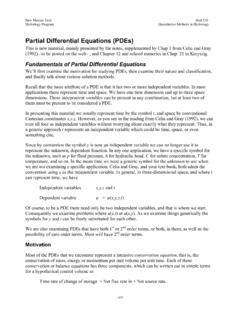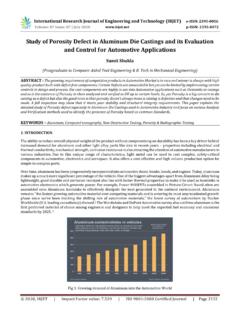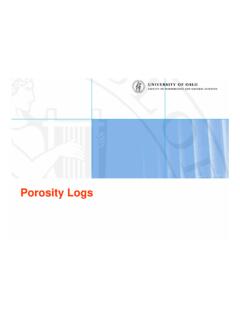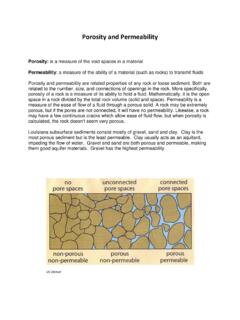Transcription of Hydraulic Conductivity & Porosity
1 1 Hydraulic Conductivity & Porosity Today Hydraulic Conductivity Porosity Aquifer, Aquitard, etcnoise-to-signal photosDoes K change if we change theporous medium? Yes Hydraulic Conductivity is a property of theporous media It depends on the pore size, its distribution, and itsconnectivity In a clastic sediment this translates to a dependence on grain shape, size, and sorting K dependence on porous media isrepresented by a measurable property, theintrinsic permeability, k [L2]2 Intrinsic Permeability, k k ! L2 , where we could define L in terms of acharacteristic distance, say grain size. For perfectly sorted ( , uniform diameter)spherical glass beads, k can be predicted on thebasis of diameter, d alone k ! d2 If the grain size varies then use, , mediangrain size for d. What is the proportionality coeffcient?
2 Lots of empirical and some theoretical models .. See text and other referencesEmpirical Intrinsic Permeability, k For real, mixed diameter and odd shaped grains,a proportionality constant, C, must be included toaccount for grain size distribution, grain shape,and packing: k = C d23 Relationship to Porosity Note that k typically cannot be correlatedwith Porosity . For example, clay has a very high porositybut very low permeability, while well-sorted gravel, which also has highporosity, has a high permeability However, within a single lithologic type(such as sandstone), k typically increaseswith increasing Porosity , and Size Large grains: Small grains:4 Sorting and Size Well sorted grains: Poorly sorted grains:wikipediaSorting and Size Well sorted sandstone: This is an example of well-rounded,clean sandstone.
3 The green areais open pore space. This rock hashigh Porosity and probably highpermeability also. Poorly sorted sandstone: Poorly sorted coarse spaces between the large,well-rounded grains are filled bysmall angular fragments in adark clay-rich matrix. This rockhas very low Porosity andpermeability. ~jtoro/Petroleum/Review% 5 Does K change if we change thefluid in the porous medium? Yes! Hydraulic Conductivity is a property of the fluid Mainly the fluid dynamic viscosity, [M/LT] But also the fluid density, ! [M/L3] Often written instead in terms of Kinematic viscosity," = /! [L2/T] Specific weight, # = ! g [M/L2T2] Both ! and " depend on temperature and pressure Through an equation of state (EOS) How does K change with increasing & !? Decreases with Increases with ! 1!K!"K ! "#KK is a property of both the fluid &the porous medium We get:and we can also nowexpress Darcy s Lawin terms of thesequantities: !
4 GkK =lllddhkgddhgkddhkAQq! " #$=$=$==6K is a property of both the fluid &the porous medium For example, usingthe empirical model,k = C d2 and !gCdK 2=lddhgCdAQq!2"==The basic units for Conductivity , K Units are [L/T] Commonly employed in current andhistorical literature and reports: SI (preferable): m/s Meinzer (old USGS): gal per day per square foot = gal d-1 ft-2 = [L3 T-1 L-2] = [L/T] USGS (recent) and most consultants: ft/d7 The basic units for permeability, k Units are [L2] Commonly employed in current and historicalliterature and reports: SI (preferable): m2, preferable but the numbers are very small ! cm2, now commonly used ft2, now less common Darcy, common in oil, gas and deep basin work One darcy is the k which will permitq=1 cm/s for = 1 cP at g(dh/dl) = 1 atm/cm 1 darcy " 10-12 m2 = 10-8 cm2 Natural Variation of K Its huge!
5 Over 13 orders of magnitude!Typical ranges of values: K (m/s)Gravel10-3 to 101 Sand10-7 to 10-2 Silt10-9 to 10-5 Clay & Shale10-12 to 10-9 Karst limestone10-5 to 10-1 Sandstone10-10 to 10-5 Igneous & Metamorphic rocks10-13 to 10-10 (unfractured)Use values in your text and cite them8 Natural Variation of K Its huge! Over 13orders of magnitude!Miocene alluvial fan sedimentsin Southern a mixture of debris flow andchannel/ sheetflood : The wide variation in grainsize and in sorting suggesting widespatial variation of Conductivity injust this one Variation of K Its huge! Over 13 orders of magnitude!Typical ranges of values: K (m/s)Gravel10-3 to 101 Sand10-7 to 10-2 Silt10-9 to 10-5 Clay & Shale10-12 to 10-9 Karst limestone10-5 to 10-1 Sandstone10-10 to 10-5 Igneous & Metamorphic rocks10-13 to 10-10 (unfractured)Good aquifers: 10-5 < K < 10-3 m/sAquitards: 10-11 < K < 10-7 m/sTypical values9 Aquifers, Aquitards, and Aquicludes Aquifer: a saturated permeable geologic unitthat can store & transmit significant quantities ofgroundwater under ordinary Hydraulic gradients&/or can yield economic quantities of water towells ( , store and transmit water) Aquitard: permeable geologic unit capable oftransmitting geologically significant amounts ofwater, but not economic quantities Aquiclude.
6 A geologic unit that cannot transmitgeologically significant amounts of waterThese are relative terms; depend on local or regional : What is a Confined aquifer? Phreatic aquifer? Perched aquifer? Water table? Capillary fringe?10 Natural Variation of Conductivity , K Its huge! In nature, over 13orders of magnitude!Typical ranges of values: K (m/s)Gravel10-3 to 101 Sand10-7 to 10-2 Silt10-9 to 10-5 Clay & Shale10-12 to 10-9 Karst limestone10-5 to 10-1 Sandstone10-10 to 10-5 Igneous & Metamorphic rocks10-13 to 10-10 (unfractured)Use values in your text and cite themSZ 2005 Natural Variation of Porosity , n Its varies much less,but the variation isstill important. In nature, n varies over 3 orders of magnitude while ne varies n (%)Gravel25 - 40 Clay40 - 70 Karst Limestone5 - 50 Sandstone5 30 Crystalline Rock0 5 Normally, well-sorted sedimentary materials have a larger Porosity than poorlysorted ones, due to filling of the voids between larger grains by smaller ones.
7 (Fetter, 2001)SZ 200511 Natural Variation of Conductivity , K,in a particular deposit Its still huge! In a particular depositnot unusual to be 7orders of magnitude!Miocene alluvial fan sedimentsin Southern a mixture of debris flow andchannel/ sheetflood : The wide variation in grain size and insorting suggesting wide spatial variation ofconductivity (& Porosity ) in just this measures Hydraulic properties at a point, not necessarily for awhole system. If K is the same at all points, the system isuniform or homogeneous. If not, it is in natural systems:sand with clay lensesconnected fracturesHomogeneous/Heterogeneous depositsLesson today: averaging or upscaling heterogeneity leads to (upscaled) anisotopy12 Property Types Scalar Properties Have no directional component Examples Porosity , Density, Compressibility, Viscosity States: Pressure, Heads, Concentrations Vector or Tensor Properties Have directional component Isotropic v.
8 Anisotropic Isotropic: same in all directions Anisotropic: property varies with direction Examples: Permeability, Hydraulic Conductivity (later: Transmissivity) States: specific discharge, seepage velocity, solute flux densityProperties as functions oflocation and directionHOMOGENEOUSHETEROGENEOUSP roperty changes with locationProperty constant with locationPropertyconstantwithdirectionPro pertychangeswithdirectionISOTROPICANISOT ROPIC13 How does averaging or upscalingheterogeneity leads to (upscaled) anisotopy?first upscaled volumesecond upscaled volumeoriginal volumeSpatially average the heterogeneitiesreduces heterogeneitycreates anisotropy(smooths)K1K2K3b3b2b1hAhB#LHet erogeneity:flow parallel to layersABHow much water flow from the reservoir at A to the reservoir at B?What is the rate of specific discharge and seepage velocity in each layer?
9 How long would it take a non-reactive tracer to move from A to B in each layer?steady flow14 Heterogeneity:flow parallel to layersK1K2K3b3b2b1hAhB#LLhwbKQLhwbKQLhwb KQ!!"=!!"=!!"=)()()(333222111 Head differencein each layer (same):hA hB = -#hWidth (into page): w Area of layer i: wbi, i=1,2,3 Discharge in each layer [L3/T]:LhwbKQiii!!"=)(or, generalizing for layer i, How much water flow from the reservoir at A to the reservoir at B?where i=1,2,3 LhwbKQLhwbKQLhwbKQ!!"=!!"=!!"=)()()(3332 22111 Heterogeneity:flow parallel to layersK1K2K3b3b2b1hAhB#LDischarge in each layer [L3/T]:or, generalizing for layer i, How much water flow from the reservoir at A to the reservoir at B?where i=1,2,3:Total Dischargeover all three layers?32131 QQQQQ iitotal++==!=LhwbKQiii!!"=)(Use conservation of mass or continuity: Total discharge = sum of layer discharges15 Heterogeneity:flow parallel to layers)(332211bKbKbKLhwQtotal++!
10 !"=K1K2K3b3b2b1hAhB#LHow much water flow from the reservoir at A to the reservoir at B?Total Dischargeover all three layers? Use conservation of mass or continuity: Total discharge = sum of layer discharges32131 QQQQQ iitotal++==!=or!!=====""#=++""#=3131321i vity transmiss total smissivitylayer tran example thisin where,)(:layers toparallelflow for rmanother te introduce ll we'Later,iiiiiiiitotalbKTTbKTTLhwTTTLhwQ Heterogeneity:flow parallel to layersLhwbKQiii!!"=)(LhKwbQqiiii!!"==Lhn Knqvieiieii!!"==,,K1K2K3b3b2b1hAhB#LDisc harge in layer i [L3/T]:where i=1,2,3:What is the rate of specific discharge and seepage velocity in each layer?Specific discharge in layer i [L/T]:Seepage velocity in layer i [L/T]:How long would it take a non-reactive tracer to move from A to B in each layer?Travel time A to B in layer i [T]:LhnKnqvieiieii!












